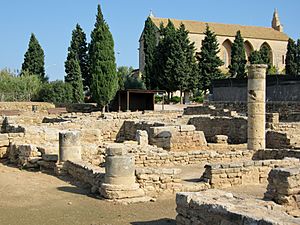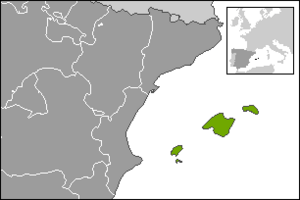Hispania Balearica facts for kids
Hispania Balearica was a Roman province that included the Balearic Islands. These islands are located off the east coast of modern-day Spain. Before becoming its own province, Balearica was part of a larger Roman area called Hispania Tarraconensis. It became independent because it was far away from the mainland and had its own strong economy.
The province included four main islands: Balearis Major (Majorca), Balearis Minor (Minorca), Ebusus (Ibiza), and the smaller island of Colubraria or Ophiusa (Formentera). Majorca and Minorca were known as the Gymnesiae islands. Ibiza and Formentera were called the Pityusae islands.
Contents
Roman Conquest of the Islands

Before the Romans arrived, people from the Talaiotic culture lived on the islands. Later, Phoenicians also settled there. For example, the main city of Minorca, Mago (Mahon), was started by the Carthaginians.
The Balearic Islands had great harbors, especially on Majorca. This made them a perfect hiding spot for pirates from Sardinia and southern Gaul. These pirates were causing trouble for Roman trade.
In 123 BC, a Roman leader named Q. Caecilius Metellus led a campaign to conquer the islands. His forces easily defeated the local people. Even though it wasn't a huge military battle, Metellus was celebrated with a special parade called a Roman triumph in 121 BC. He also earned the nickname "Balearicus" for bringing the islands under Roman control.
Metellus then founded two new Roman settlements on Majorca: Palma and Pollentia. Pollentia became the capital city of the new Roman territory.
Historians like Florus, Orosius, and Strabo wrote about why the Romans invaded the islands in 123 BC. Pirates were escaping Roman attacks in other areas and hiding in the Balearics. The islands were the last place for them to hide in the western Mediterranean Sea. Controlling the islands also made it easier for Rome to trade and move supplies between Spain and Italy. The islands were also very fertile, meaning they had good land for farming.
Also, in 123 BC, a powerful Roman politician named Gaius Gracchus was a tribune. He had many supporters in Spain and Asia, so he was very interested in seeing the islands captured and made peaceful. While other reasons like trade and military control were important, the main goal was to stop the pirates and secure the region.
Island Economy and Trade
The Balearic Islands were very important for the Roman economy. Because of this, Metellus settled 3,000 "Romans" on Majorca in the two new towns, Palma and Pollentia. These settlements showed how important it was for Rome to have strong control over the islands.
Historians debate where these settlers came from. It's thought that many were veterans from wars in Spain or people of mixed Roman and Spanish heritage. Pollentia was on the northern side of Majorca and served as a port for ships traveling to or from Gaul and Hispania Tarraconensis. Palma, the larger settlement, had a big, safe harbor. It was perfectly placed for ships using the trade winds from Baetica (another part of Spain) and Mauretania Caesariensis (North Africa).
The Balearics had many valuable goods to trade. Pliny the Elder, a Roman writer, visited the islands and described their economy. They produced excellent wheat, which was better than wheat from other parts of Spain. For example, Balearic wheat made more bread from the same amount of grain.
The islands also traded in snails and fine wine, which was popular with the Romans. Balearica soon became a major center for wine production. The sea around the islands was full of oysters, tuna, and mackerel. The islands also had dye-works, which made dyes for wool manufacturers in Baetica. This wool was then sent to markets in Italy and the East. The islands were also rich in red ochre, a natural red pigment used to make paint for frescos (wall paintings).
Famous Slingers
Balearica was also known for its skilled fighting slingers. The Romans often hired them as mercenaries (paid soldiers). Historians like Posidonius, Diodorus, and Strabo wrote about their amazing skills. They said that as children, the islanders had to earn their daily bread by slinging it off a post from far away. The distance depended on their age.
Some Balearic slingers fought for Julius Caesar in the Gallic War. Others fought against him at Massalia. The islands are actually named after these famous fighters. "Balearica" comes from the Greek word ballo, meaning "to sling." So, it means "land of the slinger."
Roman Government of Balearica
Before it became a separate province, Hispania Balearica was part of the fourth district of Tarraconensis. It had its own local government run by a council. This council handled local needs and connected directly with Rome. During the rule of Emperor Augustus, the people of Balearica asked for help with a huge problem: a plague of rabbits! The Emperor sent troops to help them.
Hispania Balearica became an independent province during the rule of Emperor Diocletian, sometime after 284 AD. Diocletian made big changes to how the Roman provinces were run. He wanted to separate military and civilian power. He also made provinces smaller to reduce the power of officials. All provinces were now directly controlled by the Emperor. He chose all the officials, including the legati pro praetore, who managed civilian affairs, and curators, who ran the cities within the provinces.
Balearica became a separate province because it didn't rely on the mainland for food or other basic goods. It also had special needs as a trading center that were easier to manage as a province than as just a city within a larger province. By Diocletian's time, the islands had over 30,000 people. They even got their own Roman bishop in 418 AD.
Decline and Fall
In 426 AD, the Vandals, led by King Gunderic, captured Carthago Nova. This city was the main naval base in the Western Mediterranean. That same year or the next, Gunderic led a raid on Balearica.
In 455 AD, after the death of Emperor Valentinian III, Gunderic's successor, Gaiseric, took control of Balearica. Gaiseric had already established himself in North Africa. He also took Corsica and Sardinia. He likely wanted these islands to use as naval bases to attack Roman ships.
Around 553 AD, forces of the Byzantine general Belisarius recaptured the islands for the Byzantine Empire. The islands remained part of the Byzantine Empire until probably the tenth century. At that time, they were taken over by the Caliphate of Córdoba.
See also
 In Spanish: Baleárica (provincia romana) para niños
In Spanish: Baleárica (provincia romana) para niños


